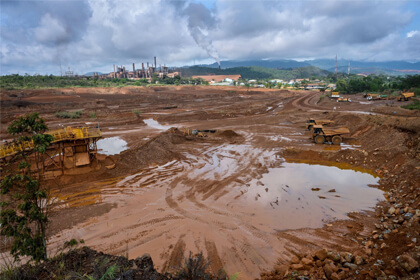How to Process Different Layers of Lateritic Nickel Ore?
 Shirley
Shirley
 Mar 16, 2023
Mar 16, 2023
 1119
1119
If you want to know more details about equipment, solutions, etc, please click the button below for free consultation, or leave your requirements!

Lateritic nickel ore is a clay-like ore formed by long-term weathering, leaching, and sedimentation of oxide nickel deposits, containing water-containing oxides of iron, aluminum, silicon, and other elements. Lateritic nickel ore is divided into brown iron ore layer, transition layer, and humus soil layer according to the distribution of different layers. The smelting process applied to different layers of lateritic nickel ore is also different. In this article, we will introduce the processing methods of lateritic nickel ore according to different layers.

01Brown iron ore layer lateritic nickel ore
BackBrown iron ore layer lateritic nickel ore mainly contains brown iron ore, needle iron ore, hydroxy-aluminum ore, chromite, etc., often containing a certain amount of cobalt. Generally, this type of lateritic nickel ore is suitable for wet process, mainly using high-pressure acid leaching process, and sulfuric acid is used for reaction in a high-pressure autoclave. Nickel, cobalt, and other valuable metals can be comprehensively recovered. The reaction process is relatively environmentally friendly, but regular maintenance of the high-pressure autoclave is required due to corrosion and scaling during the production process.
In addition, alkaline leaching process is also used for brown iron ore layer lateritic nickel ore. This method is based on high-concentration alkali metal or molten sodium hydroxide system, and uses carbonization decomposition method and ammonia leaching method to extract silicon, magnesium, nickel, and iron in turn, realizing the comprehensive utilization of lateritic nickel ore.
02Transition layer lateritic nickel ore
BackThis layer of ore is located between the brown iron ore layer and the humus soil layer, also known as the clay band or green talc band, containing green talc, silicon dioxide, and a small amount of needle iron ore. Nickel exists in different oxide forms in green talc manganese ore. The processing technology of this type of lateritic nickel ore mainly includes atmospheric acid leaching process, reduction roasting-ammonia leaching process, and small blast furnace process.
The steps of atmospheric acid leaching include slurry preparation, nickel leaching, nickel precipitation recovery or purification. This process can achieve the enrichment of nickel in laterite nickel ore, using organic acid with less environmental pollution, relatively low loss and cost, and low equipment maintenance costs.
The main processes of reduction roasting-ammonia leaching technology include laterite nickel ore drying, reduction roasting, multi-stage countercurrent ammonia leaching, selective precipitation to obtain carbonate precipitation, and calcination to obtain nickel block products. Its process flow is relatively long, reagents can be recycled, consumption is small, and it can effectively recover nickel and cobalt comprehensively.
The small blast furnace process mainly produces medium nickel iron with a nickel content of 5%~8% in blast furnaces below 200 cubic meters, and recovers nickel and iron, two valuable metals in laterite nickel ore. The product can be used as primary raw material for stainless steel.

03Humus soil layer lateritic nickel ore
BackThe laterite nickel ore in the humus layer contains mainly serpentine, quartz, talc, and olivine, with a high nickel content but uneven chemical composition and mineral composition. This type of nickel ore is mainly recovered by reduction roasting-magnetic separation process, rotary kiln pre-reduction-electric furnace smelting process, reduction roasting-acid leaching process, and hydrothermal method.
Reduction roasting-magnetic separation process mainly includes two stages: reduction of iron-nickel oxides and growth of iron-nickel particles. This process uses reduction to promote the growth of metal particles, improve the fine and uneven distribution of nickel minerals. Generally, coal powder is used as a reducing agent to enrich nickel and iron in laterite nickel ore, and reduce it to metallic iron and nickel at a temperature lower than the melting point of the ore, so that nickel-iron alloy can be effectively separated.
Rotary kiln pre-reduction-electric furnace smelting process mainly includes drying, calcination, pre-reduction, and smelting processes. Laterite nickel ore contains a large amount of free water and combined water, which need to be removed by drying and calcination. At high temperatures, nickel ore is reduced by reducing gas, and good nickel recovery can be obtained after smelting. This process is suitable for processing laterite nickel ore with higher nickel grade, but cannot recover cobalt minerals.
Reduction roasting-acid leaching process is carried out at room temperature, which can reduce the dissolution of iron, and nickel and cobalt enter the solution under acidic conditions, with high leaching rate and good selectivity. It is suitable for laterite nickel ore with higher nickel and cobalt content in the humus layer.
Hydrothermal method, also known as hot fluid method, is a chemical reaction conducted in a closed pressure vessel with water as the solvent under high temperature and pressure conditions. According to different types of reactions, it can be divided into hydrothermal oxidation, hydrothermal reduction, hydrothermal precipitation, hydrothermal synthesis, hydrothermal hydrolysis, and hydrothermal crystallization. Among them, hydrothermal crystallization is more common and can be used to process laterite nickel ore in humus soil.
04To Wrap Up
BackThe above is the processing method of laterite nickel ore in different ore layers. Before we also talked about the nickel mining process guide. In actual production, the properties of the original ore change with the mining boundary, and it is necessary to consider according to the actual situation. Therefore, the author suggests that before building a beneficiation plant, scientific and reasonable process plans should be developed through beneficiation tests, design, and other methods to achieve ideal economic benefits.
 +86 18716000713
+86 18716000713 xlyin@xinhaimining.net
xlyin@xinhaimining.net




 Message
Message Chat Now
Chat Now

















